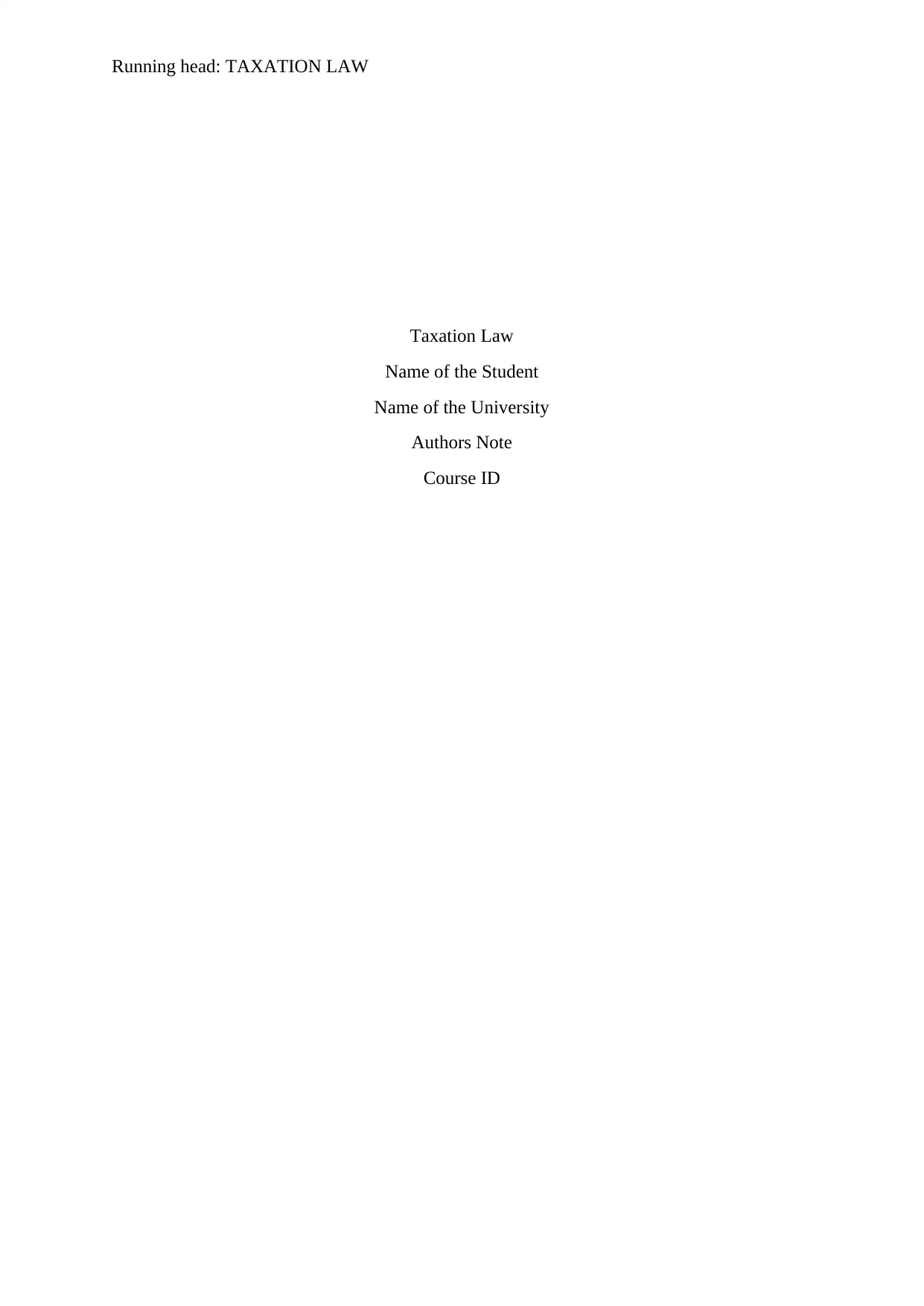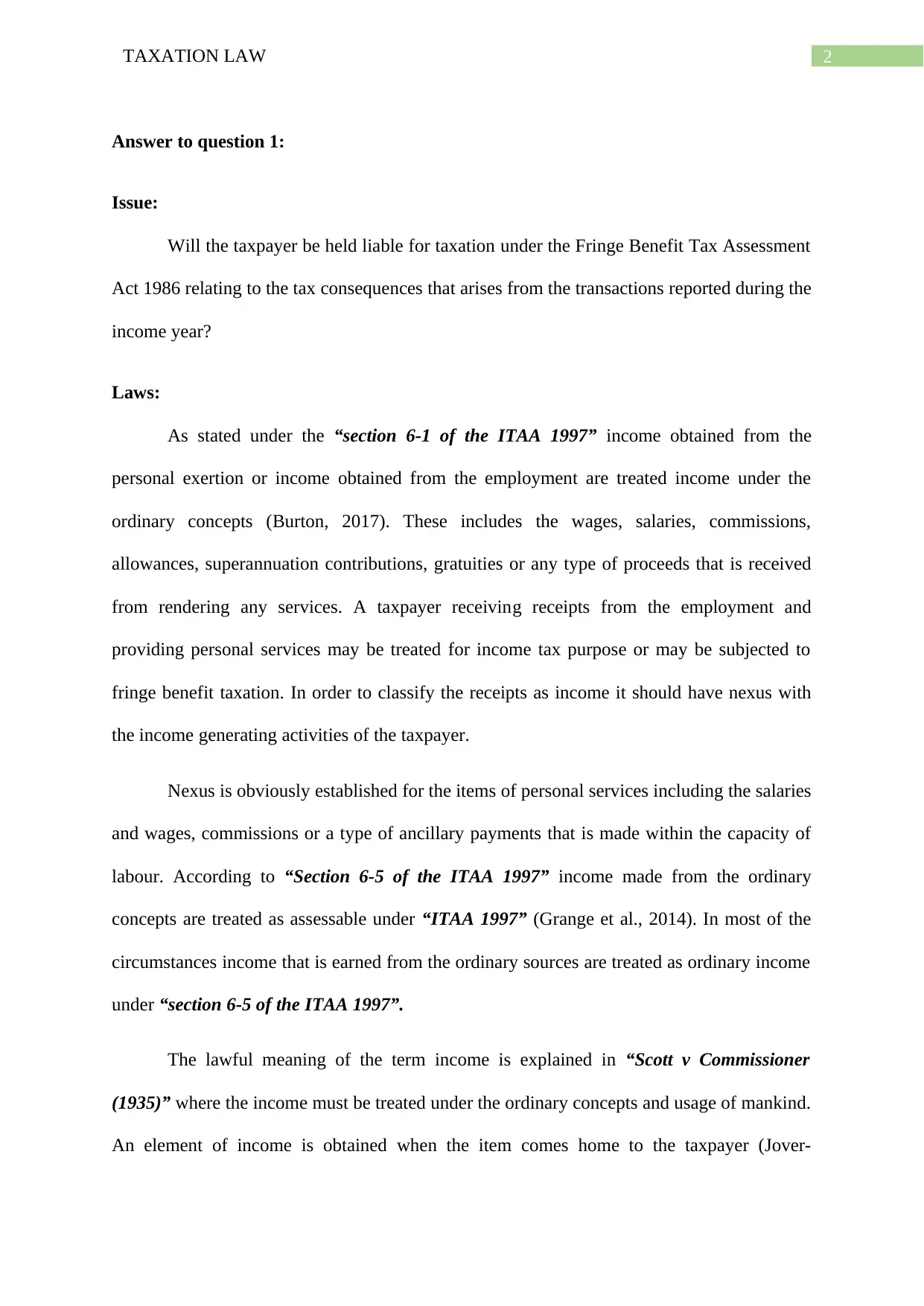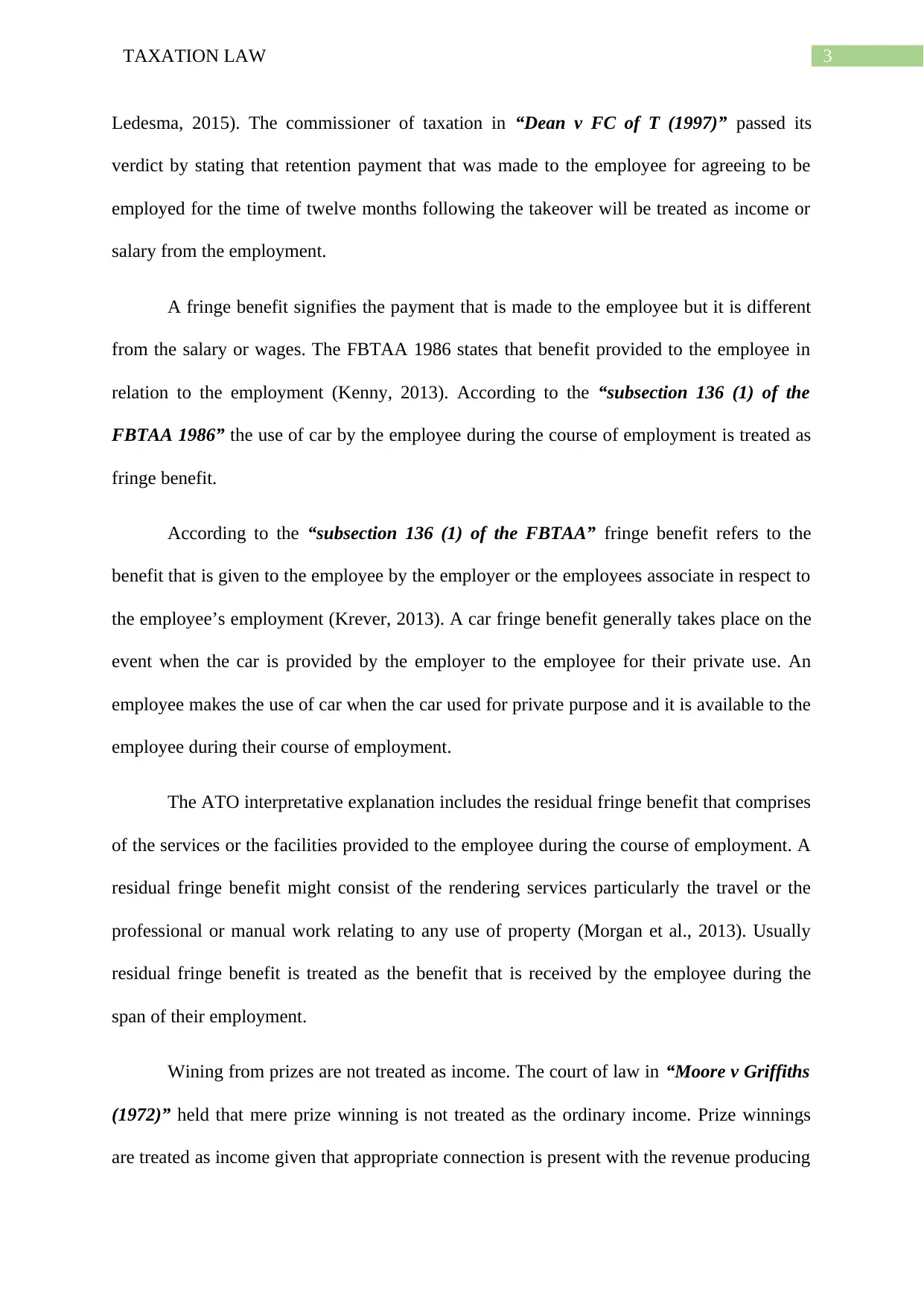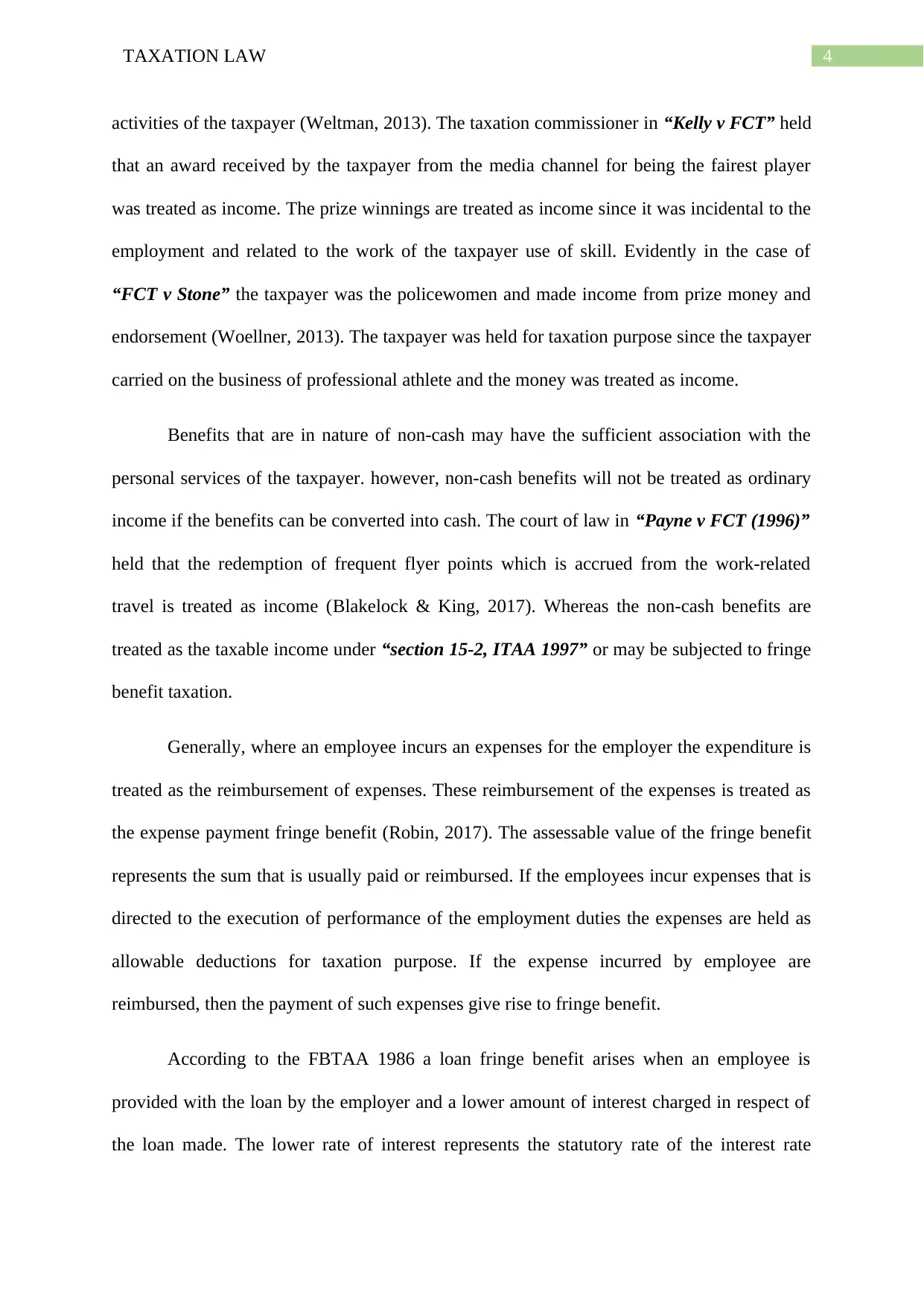Taxation Law: Fringe Benefit Tax Assessment Act 1986
VerifiedAdded on 2023/06/05
|8
|2148
|394
AI Summary
This article discusses the Fringe Benefit Tax Assessment Act 1986 and its implications on taxation law. It explains the concept of income and fringe benefits in relation to employment, citing relevant laws and cases. The article also provides an analysis of a case study to illustrate the application of the Act.
Contribute Materials
Your contribution can guide someone’s learning journey. Share your
documents today.

Running head: TAXATION LAW
Taxation Law
Name of the Student
Name of the University
Authors Note
Course ID
Taxation Law
Name of the Student
Name of the University
Authors Note
Course ID
Secure Best Marks with AI Grader
Need help grading? Try our AI Grader for instant feedback on your assignments.

1TAXATION LAW
Table of Contents
Answer to question 1:.................................................................................................................2
Issue:..........................................................................................................................................2
Laws:..........................................................................................................................................2
Application:................................................................................................................................5
Conclusion:................................................................................................................................6
References..................................................................................................................................7
Table of Contents
Answer to question 1:.................................................................................................................2
Issue:..........................................................................................................................................2
Laws:..........................................................................................................................................2
Application:................................................................................................................................5
Conclusion:................................................................................................................................6
References..................................................................................................................................7

2TAXATION LAW
Answer to question 1:
Issue:
Will the taxpayer be held liable for taxation under the Fringe Benefit Tax Assessment
Act 1986 relating to the tax consequences that arises from the transactions reported during the
income year?
Laws:
As stated under the “section 6-1 of the ITAA 1997” income obtained from the
personal exertion or income obtained from the employment are treated income under the
ordinary concepts (Burton, 2017). These includes the wages, salaries, commissions,
allowances, superannuation contributions, gratuities or any type of proceeds that is received
from rendering any services. A taxpayer receiving receipts from the employment and
providing personal services may be treated for income tax purpose or may be subjected to
fringe benefit taxation. In order to classify the receipts as income it should have nexus with
the income generating activities of the taxpayer.
Nexus is obviously established for the items of personal services including the salaries
and wages, commissions or a type of ancillary payments that is made within the capacity of
labour. According to “Section 6-5 of the ITAA 1997” income made from the ordinary
concepts are treated as assessable under “ITAA 1997” (Grange et al., 2014). In most of the
circumstances income that is earned from the ordinary sources are treated as ordinary income
under “section 6-5 of the ITAA 1997”.
The lawful meaning of the term income is explained in “Scott v Commissioner
(1935)” where the income must be treated under the ordinary concepts and usage of mankind.
An element of income is obtained when the item comes home to the taxpayer (Jover-
Answer to question 1:
Issue:
Will the taxpayer be held liable for taxation under the Fringe Benefit Tax Assessment
Act 1986 relating to the tax consequences that arises from the transactions reported during the
income year?
Laws:
As stated under the “section 6-1 of the ITAA 1997” income obtained from the
personal exertion or income obtained from the employment are treated income under the
ordinary concepts (Burton, 2017). These includes the wages, salaries, commissions,
allowances, superannuation contributions, gratuities or any type of proceeds that is received
from rendering any services. A taxpayer receiving receipts from the employment and
providing personal services may be treated for income tax purpose or may be subjected to
fringe benefit taxation. In order to classify the receipts as income it should have nexus with
the income generating activities of the taxpayer.
Nexus is obviously established for the items of personal services including the salaries
and wages, commissions or a type of ancillary payments that is made within the capacity of
labour. According to “Section 6-5 of the ITAA 1997” income made from the ordinary
concepts are treated as assessable under “ITAA 1997” (Grange et al., 2014). In most of the
circumstances income that is earned from the ordinary sources are treated as ordinary income
under “section 6-5 of the ITAA 1997”.
The lawful meaning of the term income is explained in “Scott v Commissioner
(1935)” where the income must be treated under the ordinary concepts and usage of mankind.
An element of income is obtained when the item comes home to the taxpayer (Jover-

3TAXATION LAW
Ledesma, 2015). The commissioner of taxation in “Dean v FC of T (1997)” passed its
verdict by stating that retention payment that was made to the employee for agreeing to be
employed for the time of twelve months following the takeover will be treated as income or
salary from the employment.
A fringe benefit signifies the payment that is made to the employee but it is different
from the salary or wages. The FBTAA 1986 states that benefit provided to the employee in
relation to the employment (Kenny, 2013). According to the “subsection 136 (1) of the
FBTAA 1986” the use of car by the employee during the course of employment is treated as
fringe benefit.
According to the “subsection 136 (1) of the FBTAA” fringe benefit refers to the
benefit that is given to the employee by the employer or the employees associate in respect to
the employee’s employment (Krever, 2013). A car fringe benefit generally takes place on the
event when the car is provided by the employer to the employee for their private use. An
employee makes the use of car when the car used for private purpose and it is available to the
employee during their course of employment.
The ATO interpretative explanation includes the residual fringe benefit that comprises
of the services or the facilities provided to the employee during the course of employment. A
residual fringe benefit might consist of the rendering services particularly the travel or the
professional or manual work relating to any use of property (Morgan et al., 2013). Usually
residual fringe benefit is treated as the benefit that is received by the employee during the
span of their employment.
Wining from prizes are not treated as income. The court of law in “Moore v Griffiths
(1972)” held that mere prize winning is not treated as the ordinary income. Prize winnings
are treated as income given that appropriate connection is present with the revenue producing
Ledesma, 2015). The commissioner of taxation in “Dean v FC of T (1997)” passed its
verdict by stating that retention payment that was made to the employee for agreeing to be
employed for the time of twelve months following the takeover will be treated as income or
salary from the employment.
A fringe benefit signifies the payment that is made to the employee but it is different
from the salary or wages. The FBTAA 1986 states that benefit provided to the employee in
relation to the employment (Kenny, 2013). According to the “subsection 136 (1) of the
FBTAA 1986” the use of car by the employee during the course of employment is treated as
fringe benefit.
According to the “subsection 136 (1) of the FBTAA” fringe benefit refers to the
benefit that is given to the employee by the employer or the employees associate in respect to
the employee’s employment (Krever, 2013). A car fringe benefit generally takes place on the
event when the car is provided by the employer to the employee for their private use. An
employee makes the use of car when the car used for private purpose and it is available to the
employee during their course of employment.
The ATO interpretative explanation includes the residual fringe benefit that comprises
of the services or the facilities provided to the employee during the course of employment. A
residual fringe benefit might consist of the rendering services particularly the travel or the
professional or manual work relating to any use of property (Morgan et al., 2013). Usually
residual fringe benefit is treated as the benefit that is received by the employee during the
span of their employment.
Wining from prizes are not treated as income. The court of law in “Moore v Griffiths
(1972)” held that mere prize winning is not treated as the ordinary income. Prize winnings
are treated as income given that appropriate connection is present with the revenue producing
Secure Best Marks with AI Grader
Need help grading? Try our AI Grader for instant feedback on your assignments.

4TAXATION LAW
activities of the taxpayer (Weltman, 2013). The taxation commissioner in “Kelly v FCT” held
that an award received by the taxpayer from the media channel for being the fairest player
was treated as income. The prize winnings are treated as income since it was incidental to the
employment and related to the work of the taxpayer use of skill. Evidently in the case of
“FCT v Stone” the taxpayer was the policewomen and made income from prize money and
endorsement (Woellner, 2013). The taxpayer was held for taxation purpose since the taxpayer
carried on the business of professional athlete and the money was treated as income.
Benefits that are in nature of non-cash may have the sufficient association with the
personal services of the taxpayer. however, non-cash benefits will not be treated as ordinary
income if the benefits can be converted into cash. The court of law in “Payne v FCT (1996)”
held that the redemption of frequent flyer points which is accrued from the work-related
travel is treated as income (Blakelock & King, 2017). Whereas the non-cash benefits are
treated as the taxable income under “section 15-2, ITAA 1997” or may be subjected to fringe
benefit taxation.
Generally, where an employee incurs an expenses for the employer the expenditure is
treated as the reimbursement of expenses. These reimbursement of the expenses is treated as
the expense payment fringe benefit (Robin, 2017). The assessable value of the fringe benefit
represents the sum that is usually paid or reimbursed. If the employees incur expenses that is
directed to the execution of performance of the employment duties the expenses are held as
allowable deductions for taxation purpose. If the expense incurred by employee are
reimbursed, then the payment of such expenses give rise to fringe benefit.
According to the FBTAA 1986 a loan fringe benefit arises when an employee is
provided with the loan by the employer and a lower amount of interest charged in respect of
the loan made. The lower rate of interest represents the statutory rate of the interest rate
activities of the taxpayer (Weltman, 2013). The taxation commissioner in “Kelly v FCT” held
that an award received by the taxpayer from the media channel for being the fairest player
was treated as income. The prize winnings are treated as income since it was incidental to the
employment and related to the work of the taxpayer use of skill. Evidently in the case of
“FCT v Stone” the taxpayer was the policewomen and made income from prize money and
endorsement (Woellner, 2013). The taxpayer was held for taxation purpose since the taxpayer
carried on the business of professional athlete and the money was treated as income.
Benefits that are in nature of non-cash may have the sufficient association with the
personal services of the taxpayer. however, non-cash benefits will not be treated as ordinary
income if the benefits can be converted into cash. The court of law in “Payne v FCT (1996)”
held that the redemption of frequent flyer points which is accrued from the work-related
travel is treated as income (Blakelock & King, 2017). Whereas the non-cash benefits are
treated as the taxable income under “section 15-2, ITAA 1997” or may be subjected to fringe
benefit taxation.
Generally, where an employee incurs an expenses for the employer the expenditure is
treated as the reimbursement of expenses. These reimbursement of the expenses is treated as
the expense payment fringe benefit (Robin, 2017). The assessable value of the fringe benefit
represents the sum that is usually paid or reimbursed. If the employees incur expenses that is
directed to the execution of performance of the employment duties the expenses are held as
allowable deductions for taxation purpose. If the expense incurred by employee are
reimbursed, then the payment of such expenses give rise to fringe benefit.
According to the FBTAA 1986 a loan fringe benefit arises when an employee is
provided with the loan by the employer and a lower amount of interest charged in respect of
the loan made. The lower rate of interest represents the statutory rate of the interest rate

5TAXATION LAW
(Sadiq, 2014). The assessable value of the loan fringe benefit comprises of the differences
between the interest which is accrued in the fringe benefit year when the statutory interest
rate has been implemented which is originally accrued.
Application:
The current situation is based on ascertaining the fringe benefit tax consequences for
Jamie working as the real estate agent for Houses R Us a real estate company. The contract of
employment stipulates a payment of $50,000. The receipt of salary by Jamie will be treated
as salary income or income from personal employment under “section 6-5 of the ITAA
1997”. The salary income will be included in the Jamie’s taxable return which will attract tax
liability. The receipts should be treated as income under the ordinary concepts as it held as
the income under the ordinary concepts (Blakelock & King, 2017). Citing the situation of
“Dean v FC of T (1997)” the receipt of salary would be treated as the payment from work.
Evidence from the case suggest that House R Us provided Jamie with the car so that
he can it for the private or work purpose. With respect to the “subsection 136 (1) of the
FBTAA 1986” the use of car by Jamie during the course of employment will be treated as
fringe benefit (Robin, 2017). The car fringe benefit refers to the benefit provided in the
course of employment. The usage of car by Jamie should be treated as car fringe benefit since
the car used both within and outside the working hours.
In the later part of the case study it is found that Jamie with the salary package which
comprised of the laptop and mobile phone. House R Us also reimbursed Jamie with the
mobile phone expenses amounting to $1,200. Furthermore, House R Us reimbursed Jamie
with the sum of $550 and paid him with the entertainment allowance. In the current situation
Jamie also occurred expenses for his employer House R U’s. The employer reimbursed the
expenses incurred by Jamie during his employment course. The reimbursement of expenses
(Sadiq, 2014). The assessable value of the loan fringe benefit comprises of the differences
between the interest which is accrued in the fringe benefit year when the statutory interest
rate has been implemented which is originally accrued.
Application:
The current situation is based on ascertaining the fringe benefit tax consequences for
Jamie working as the real estate agent for Houses R Us a real estate company. The contract of
employment stipulates a payment of $50,000. The receipt of salary by Jamie will be treated
as salary income or income from personal employment under “section 6-5 of the ITAA
1997”. The salary income will be included in the Jamie’s taxable return which will attract tax
liability. The receipts should be treated as income under the ordinary concepts as it held as
the income under the ordinary concepts (Blakelock & King, 2017). Citing the situation of
“Dean v FC of T (1997)” the receipt of salary would be treated as the payment from work.
Evidence from the case suggest that House R Us provided Jamie with the car so that
he can it for the private or work purpose. With respect to the “subsection 136 (1) of the
FBTAA 1986” the use of car by Jamie during the course of employment will be treated as
fringe benefit (Robin, 2017). The car fringe benefit refers to the benefit provided in the
course of employment. The usage of car by Jamie should be treated as car fringe benefit since
the car used both within and outside the working hours.
In the later part of the case study it is found that Jamie with the salary package which
comprised of the laptop and mobile phone. House R Us also reimbursed Jamie with the
mobile phone expenses amounting to $1,200. Furthermore, House R Us reimbursed Jamie
with the sum of $550 and paid him with the entertainment allowance. In the current situation
Jamie also occurred expenses for his employer House R U’s. The employer reimbursed the
expenses incurred by Jamie during his employment course. The reimbursement of expenses

6TAXATION LAW
gave rise to expense payment fringe benefit for House R U’s while for Jamie it would be
treated as the fringe benefit taxation under the “FBTAA 1986”.
In the late part it is noticed that Jamie received the prize money of $4800 for attaining
the highest amount of sales during the last six months. As the part of his service Jamie was
rewarded with home entertainment system at a cost of $4,800. Referring to the judgement
made in “Kelly v FCT” the home music system constituted a non-cash benefit which is easily
converted in cash (Woellner, 2013). The award will be treated as income because it was
received by Jamie as the part of his employment from the use of skill.
Later it was noticed that Houses R Us provided their employee with a loan of $10,000
at an interest rate of 4%. While Jamie looks take up the loan of $100,000 at the lower interest
rate of 4%. This would eventually give rise to fringe benefit since the interest charged by
Houses R Us is lower than statutory interest rate. If Jamie is sure to take up the loan, then the
loan amount would constitute a difference amid the interest which may otherwise be accrued
to Jamie in the FBT year given the statutory interest rate was applied.
Conclusion:
Conclusively, the salary received is held for assessment under the ordinary concepts
of “section 6-5, ITAA 1997”. Jamie will be held liable for car fringe benefit under
“subsection 136 (1) of the FBTAA 1986”. While the sum of $4,800 will be held as reward
from employment and hence an income within the meaning of “section 6-5, ITAA 1997”.
While House R Us can claim deductions for the expense payment fringe benefit since it held
sufficient nexus with the revenue generating activities of the employer.
gave rise to expense payment fringe benefit for House R U’s while for Jamie it would be
treated as the fringe benefit taxation under the “FBTAA 1986”.
In the late part it is noticed that Jamie received the prize money of $4800 for attaining
the highest amount of sales during the last six months. As the part of his service Jamie was
rewarded with home entertainment system at a cost of $4,800. Referring to the judgement
made in “Kelly v FCT” the home music system constituted a non-cash benefit which is easily
converted in cash (Woellner, 2013). The award will be treated as income because it was
received by Jamie as the part of his employment from the use of skill.
Later it was noticed that Houses R Us provided their employee with a loan of $10,000
at an interest rate of 4%. While Jamie looks take up the loan of $100,000 at the lower interest
rate of 4%. This would eventually give rise to fringe benefit since the interest charged by
Houses R Us is lower than statutory interest rate. If Jamie is sure to take up the loan, then the
loan amount would constitute a difference amid the interest which may otherwise be accrued
to Jamie in the FBT year given the statutory interest rate was applied.
Conclusion:
Conclusively, the salary received is held for assessment under the ordinary concepts
of “section 6-5, ITAA 1997”. Jamie will be held liable for car fringe benefit under
“subsection 136 (1) of the FBTAA 1986”. While the sum of $4,800 will be held as reward
from employment and hence an income within the meaning of “section 6-5, ITAA 1997”.
While House R Us can claim deductions for the expense payment fringe benefit since it held
sufficient nexus with the revenue generating activities of the employer.
Paraphrase This Document
Need a fresh take? Get an instant paraphrase of this document with our AI Paraphraser

7TAXATION LAW
References
Blakelock, S. & King, P., (2017). Taxation law: The advance of ATO data
matching. Proctor, The, 37(6), p.18.
Burton, M. (2017). A Review of Judicial References to the Dictum of Jordan CJ, Expressed
in Scott v. Commissioner of Taxation, in Elaborating the Meaning of Income for the
Purposes of the Australian Income Tax. J. Austl. Tax'n, 19, 50.
Grange, J., Jover-Ledesma, G., & Maydew, G. (2014) principles of business taxation.
Jover-Ledesma, G. (2015). Principles of business taxation. [Place of publication not
identified]: Cch Incorporated.
Kenny, P. (2013). Australian tax. Chatswood, N.S.W.: LexisNexis Butterworths.
Krever, R. (2013). Australian taxation law cases. Pyrmont, N.S.W.: Thomson Reuters.
Morgan, A., Mortimer, C., & Pinto, D. (2013). A practical introduction to Australian
taxation law. North Ryde [N.S.W.]: CCH Australia.
Robin, H. (2017). Australian taxation law 2017. Oxford University Press.
Sadiq, K. (2014) Principles of taxation law.
Weltman, B. (2013). J.K. Lasser's 1001 deductions and tax breaks. Hoboken, N.J: John
Wiley & Sons.
Woellner, R. (2013). Australian taxation law. North Ryde [N.S.W.]: CCH Australia.
Woellner, R., Barkoczy, S., Murphy, S., Evans, C., & Pinto, D. (2014) Australian taxation
law select.
References
Blakelock, S. & King, P., (2017). Taxation law: The advance of ATO data
matching. Proctor, The, 37(6), p.18.
Burton, M. (2017). A Review of Judicial References to the Dictum of Jordan CJ, Expressed
in Scott v. Commissioner of Taxation, in Elaborating the Meaning of Income for the
Purposes of the Australian Income Tax. J. Austl. Tax'n, 19, 50.
Grange, J., Jover-Ledesma, G., & Maydew, G. (2014) principles of business taxation.
Jover-Ledesma, G. (2015). Principles of business taxation. [Place of publication not
identified]: Cch Incorporated.
Kenny, P. (2013). Australian tax. Chatswood, N.S.W.: LexisNexis Butterworths.
Krever, R. (2013). Australian taxation law cases. Pyrmont, N.S.W.: Thomson Reuters.
Morgan, A., Mortimer, C., & Pinto, D. (2013). A practical introduction to Australian
taxation law. North Ryde [N.S.W.]: CCH Australia.
Robin, H. (2017). Australian taxation law 2017. Oxford University Press.
Sadiq, K. (2014) Principles of taxation law.
Weltman, B. (2013). J.K. Lasser's 1001 deductions and tax breaks. Hoboken, N.J: John
Wiley & Sons.
Woellner, R. (2013). Australian taxation law. North Ryde [N.S.W.]: CCH Australia.
Woellner, R., Barkoczy, S., Murphy, S., Evans, C., & Pinto, D. (2014) Australian taxation
law select.
1 out of 8
Related Documents
Your All-in-One AI-Powered Toolkit for Academic Success.
+13062052269
info@desklib.com
Available 24*7 on WhatsApp / Email
![[object Object]](/_next/static/media/star-bottom.7253800d.svg)
Unlock your academic potential
© 2024 | Zucol Services PVT LTD | All rights reserved.





